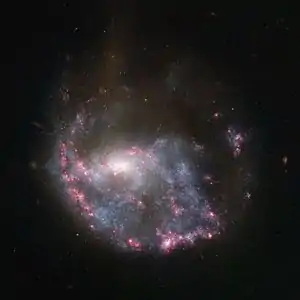NGC 922
NGC 922 is a peculiar galaxy in the southern constellation of Fornax, located at a distance of 142 Mly[4] from the Milky Way. It is one of the nearest known collisional galaxies.[8] This object was described by the Herschels as "considerably faint, pretty large, round, gradually pretty much brighter middle."[7] The general form is described by the morphological classification of SB(s)cd pec,[2] which indicates a peculiar (pec) barred spiral galaxy (SB) with no inner ring system around the bar (s) and loosely-wound spiral arms (cd).
| NGC 922 | |
|---|---|
 | |
| Observation data (J2000 epoch) | |
| Constellation | Fornax |
| Right ascension | 02h 25m 04.400s[1] |
| Declination | −24° 07′ 17.46″[1] |
| Redshift | 0.010314±0.000020[2] |
| Helio radial velocity | 3,075 km/s[3] |
| Distance | 142 Mly (43.4 Mpc)[4] |
| Apparent magnitude (V) | 12.21[5] |
| Characteristics | |
| Type | SB(s)cd pec[2] |
| Mass | 5.47×109 M☉[6] M☉ |
| Apparent size (V) | 2′.0 × 1′.7[7] |
| Other designations | |
| GSC 06433-00965, MCG-04-06-037, UGCA 30, AM 0222-250, IRAS 02228-2500, PSCz Q02228-2500, [WDW2002] HIPASS J0224-24, DUGRS 478-001, IRAS F02228-2500, RR95 53a, ESO 478-28, ISG 10, SGC 022248-2500.9, ESO-LV 478-0280, LEDA 9172, SINGG HIPASS J0224-24 S1[5] | |
This object was originally described as a dust-obscured grand-design galaxy – a term used to indicate a type of spiral galaxy with prominent and well-defined spiral arms. However, observation of its features suggests it has undergone a high-velocity, off-center collision with a nearby dwarf galaxy, designated S2 by Wong et al. (2006),[6] about 330 million years ago.[9] This has result in a distinctive C-shaped ring of Hydrogen alpha emission.[10] A stellar plume is seen extending from the galaxy toward S2,[6] located about 8′ away.[8] NGC 922 displays ring-like structures created by propagating density waves, as well as spoke-like features and an off-center star-forming bar, all of which features match models of such a collision. The current physical separation of the dwarf from NGC 922 is around 104 kpc.[6]
The main galaxy has a stellar mass estimated 5.47 billion times the mass of the Sun (solar mass), while the dwarf companion has 28.2 million solar masses. The net mass of NGC 922 is estimated as 75 billion solar masses within a radius of 13.4 kpc, with 72% being in the form of dark matter and 20% as neutral hydrogen.[6] It is a starburst galaxy,[10] and the collision has resulted in star formation at the rate of 7–8 M☉·yr−1. New star clusters have been formed in the ring or bar with a mean age of 16 million years, whereas older clusters of 50 million years or more are predominantly found in the nuclear region. The tidal plume pointing toward the companion mainly consists of much older stars, indicating not much new star formation has taken place in that feature.[8]
See also
References
- Skrutskie, M. F.; et al. (2006). "The Two Micron All Sky Survey (2MASS)". The Astronomical Journal. 131 (2): 1163–1183. Bibcode:2006AJ....131.1163S. doi:10.1086/498708.
- de Vaucouleurs, G.; et al. (1991). "Third reference catalogue of bright galaxies". 9. New York: Springer-Verlag. Cite journal requires
|journal=(help) - Jones, D. Heath; et al. (October 2009), "The 6dF Galaxy Survey: final redshift release (DR3) and southern large-scale structures", Monthly Notices of the Royal Astronomical Society, 399 (2): 683–698, arXiv:0903.5451, Bibcode:2009MNRAS.399..683J, doi:10.1111/j.1365-2966.2009.15338.x
- Mould, Jeremy R.; et al. (2000). "The Hubble Space Telescope Key Project on the Extragalactic Distance Scale. XXVIII. Combining the Constraints on the Hubble Constant". The Astrophysical Journal. 529 (2): 786–794. arXiv:astro-ph/9909260. Bibcode:2000ApJ...529..786M. doi:10.1086/308304.
- "NGC 922". SIMBAD. Centre de données astronomiques de Strasbourg. Retrieved 2020-04-04.
- Wong, O. I.; et al. (August 2006). "NGC922 - a new drop-through ring galaxy". Monthly Notices of the Royal Astronomical Society. 370 (4): 1607–1611. arXiv:astro-ph/0605613. Bibcode:2006MNRAS.370.1607W. doi:10.1111/j.1365-2966.2006.10589.x.
- Aranda, Ted (2011). 3,000 Deep-Sky Objects: An Annotated Catalogue. The Patrick Moore Practical Astronomy Series. Springer Science & Business Media. p. 89. ISBN 9781441994196.
- Pellerin, Anne; et al. (April 2010). "The Star Cluster Population of the Collisional Ring Galaxy NGC 922". The Astronomical Journal. 139 (4): 1369–1382. arXiv:1002.0009. Bibcode:2010AJ....139.1369P. doi:10.1088/0004-6256/139/4/1369.
- "Hubble view of NGC 922". ESA/Hubble Press Release. Retrieved 8 December 2012.
- Prestwich, A. H.; et al. (March 2012). "Chandra Observations of the Collisional Ring Galaxy NGC 922". The Astrophysical Journal. 747 (2): 6. arXiv:1212.1124. Bibcode:2012ApJ...747..150P. doi:10.1088/0004-637X/747/2/150. 150.
External links
 Media related to NGC 922 at Wikimedia Commons
Media related to NGC 922 at Wikimedia Commons
Coordinates: ![]() 02h 25m 03.5s, −24° 7′ 22″
02h 25m 03.5s, −24° 7′ 22″